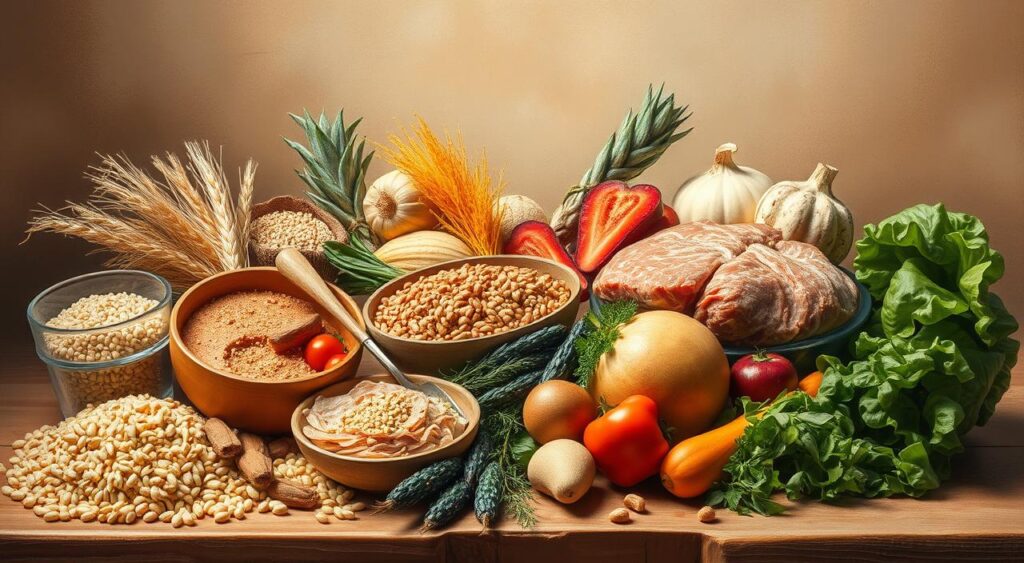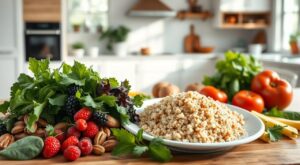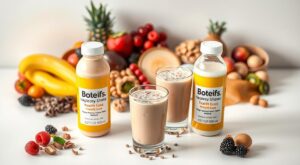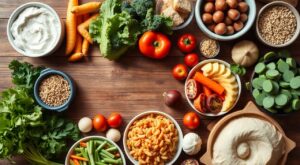Ever thought about if cutting carbs is the only way to control blood sugar? Or does timing and type play a big role too?
This guide will show you how to manage carbs with diabetes. You’ll learn about carbohydrate intake and insulin resistance. Plus, how carbs are measured in grams and why one serving is about 15 grams.
There’s no one-size-fits-all carb goal. Your target depends on your age, weight, activity level, and more. Work with your doctor to create a plan that fits your life.
Later, we’ll give examples and tips for carb amounts at meals. This article is your guide to better blood sugar control.
Understanding Carbohydrates: The Basics
Carbohydrates are a key energy source for your body. They break down into glucose, which increases blood sugar. This glucose powers muscles and the brain.
What are Carbohydrates?
Carbohydrates include sugars, starches, and fiber. Sugars are found naturally in fruits and milk, and are added to foods like sodas. Starches are in wheat, oats, potatoes, and more. Fiber is from plant cell walls and mostly passes through your gut.
Simple vs. Complex Carbs
Simple carbs, like sugars, digest quickly. They can quickly raise your blood sugar. Examples include table sugar and candy.
Complex carbs, like whole grains, digest slowly. They are rich in vitamins, minerals, and fiber. Choosing complex carbs helps control blood sugar and provides steady energy.
Fiber’s Role in Carbohydrates
Fiber doesn’t raise blood sugar because it’s not fully digested. It slows digestion, keeps you full, and lowers cholesterol. For those with diabetes, high-fiber foods are beneficial.
The Dietary Guidelines recommend at least 14 grams of fiber per 1,000 calories. Foods high in fiber include beans, nuts, fruits, and whole grains. Adding fiber to meals gradually and drinking enough water is important.
By focusing on healthy carbs for diabetes, you can manage hunger, heart health, and glucose levels.
The Impact of Carbs on Blood Sugar Levels
Carbs turn into glucose in your body. The pancreas then releases insulin to help your cells use this glucose. If insulin levels are low or your cells resist it, your blood sugar can rise. This might make you feel tired, thirsty, or see things less clearly.
To manage carbs with type 2 diabetes, balance what you eat with your meds and activity. Eating too few carbs can lead to low blood sugar, which is dangerous. It’s important to watch how much you eat and when.
Carbs come in different types, affecting blood sugar levels in different ways. Simple carbs like sugars and refined starches cause quick spikes. But, complex carbs like fiber-rich foods slow down digestion and reduce these spikes. Testing your blood sugar after meals helps you see how certain foods affect you.
Glycemic Index explained
The glycemic index ranks foods by how quickly they raise blood sugar. Foods with a low GI, like lentils and non-starchy veggies, cause slower increases. On the other hand, high-GI foods like white bread and sugary drinks lead to quick spikes.
While the glycemic index is useful, it’s just one tool. Other factors like portion size and fiber content also play a role. Tracking your carbs and testing your blood sugar after meals gives you a clear picture of what works for you.
Understanding carbs and insulin resistance helps you plan meals that keep your energy and mood stable. Aim for balanced portions of whole grains, legumes, fruits, and veggies. This approach helps control your carbs and blood sugar levels over time.
Recommended Daily Carb Intake for Diabetes
Figuring out the right carb amount for each day is key. One carb serving is about 15 grams. Many people aim for a steady blood sugar by eating the same amount of carbs at each meal.
General Guidelines for Carbs
Start by turning meal plans into grams and servings. This makes tracking easier. For example, an 1,800 kcal plan might include 200 grams of carbs, spread over three meals and a snack. That’s about 13 carb servings for the day.
If you take insulin with meals, match your insulin doses to the carbs you eat. Without insulin, limit carbs and spread them out to keep glucose stable. Using carb counting for type 2 diabetes helps make these adjustments easier and more accurate.
Factors Influencing Your Carb Needs
Your age, sex, body weight, and activity level affect your carb needs. Pregnancy and certain medications also play a role. Those with higher insulin resistance might need fewer carbs to meet their glucose goals.
Work with a registered dietitian or a DSMES program to set your own carb targets. A diabetes educator can help you practice carb counting and refine your plan. Ask your doctor for referrals or check local DSMES locators in the United States to find services near you.
Managing carbs with diabetes involves testing, tracking, and adjusting. Keep a log of grams, note how meals affect your readings, and update your plan as needed.
Choosing the Right Types of Carbohydrates
Picking the right carbs can help control blood sugar. Look for foods rich in fiber, vitamins, and minerals. Choose whole foods that are slow to digest and keep you full.
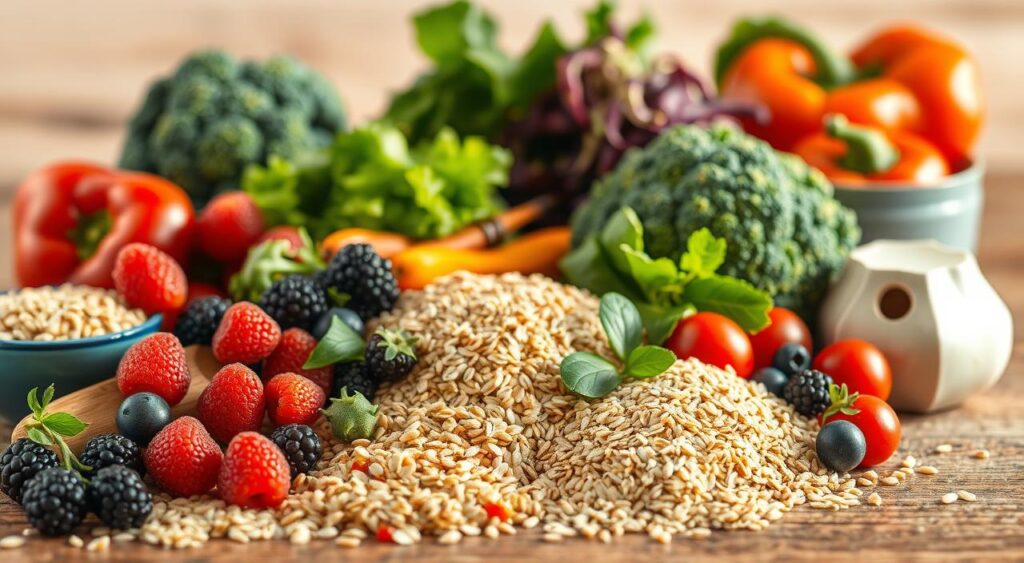
Whole grains should be a big part of your diet. Foods like oats, quinoa, and brown rice are full of fiber. They give you steady energy and help you feel full.
Whole Grains vs. Refined Grains
Refined grains lack fiber and nutrients. Even enriched products don’t have enough fiber. Stick to whole grains to avoid quick blood sugar spikes.
Stay away from refined carbs and added sugars. Foods like soda and pastries can quickly raise your blood sugar. They also add empty calories.
Fruits and Vegetables: The Best Choices
Choose whole fruits and non-starchy vegetables. Apples and berries are good choices. Lettuce and cucumbers are low in carbs but high in fiber.
Starchy vegetables and some fruits should make up a quarter of your plate. Potatoes and corn raise blood sugar more. But, pulses like lentils offer protein and fiber.
Plan meals with healthy carbs that have fiber, protein, and fats. This mix helps control blood sugar. Avoid refined snacks and sugary drinks to keep your levels steady.
Carbohydrates and Meal Planning
Planning meals helps manage carbs with diabetes better. It makes it easier and more predictable. Use simple rules to build plates that steady blood sugar and fit your lifestyle.
Start with the Plate Method: half your plate non-starchy vegetables, one-quarter lean protein, one-quarter carbohydrate. Add fruit or low-fat dairy when it fits your carb target.
Balancing Carbs with Proteins and Fats
Pair carbs with protein and healthy fats to slow digestion and blunt glucose spikes. For example, whole-grain toast with avocado and eggs gives fiber, fat, and protein in one bite.
When using mealtime insulin, count grams of carbohydrate and match doses. If you do not use insulin, focus on portion control and smart swaps.
Sample Meal Ideas
Below are meal examples based on common evidence and public resources. Adjust portions to meet your personal targets for carbs for type 2 diabetes.
| Meal | Items | Estimated Carbs (g) | Tips for Lower Carb |
|---|---|---|---|
| Breakfast | 1/2 cup rolled oats, 1 cup low-fat milk, 2/3 medium banana, walnuts | ~65 | Use 1/3 cup oats and unsweetened almond milk; add extra walnuts |
| Lunch | 2 slices whole wheat bread, turkey, cheese, veggies, baby carrots, fat-free Greek yogurt, blueberries | ~59 | Swap bread for lettuce wraps; keep yogurt portion small |
| Dinner | Baked chicken, 1 cup brown rice, 1 cup steamed broccoli | ~57 | Reduce rice to 1/2 cup and add another cup of non-starchy veg |
| Snack | Low-fat string cheese, 2 tangerines | ~19 | Choose one tangerine or swap for a small handful of almonds |
If you follow a low carb diet for diabetes, shrink starchy portions and boost non-starchy vegetables and protein. That keeps meals satisfying without large carb totals.
Use these ideas to practice managing carbs with diabetes at home and on the go. Small, consistent changes help you stay on track with your goals.
Timing Your Carbs: When to Eat
Eating carbs at the right time can affect your blood sugar levels. Eating small, steady amounts helps avoid big spikes. It’s important to match your meals to your activity, medications, and how your body reacts to carbs.
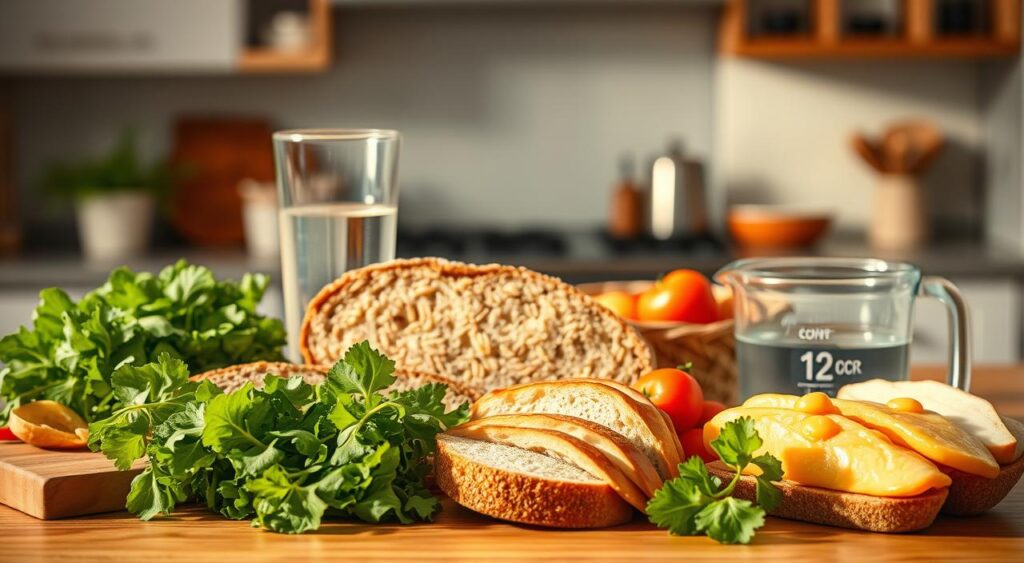
Carbs Around Physical Activity
Exercise makes your body better at using insulin and taking in glucose. For short walks or light workouts, you might need less carbs or insulin. But for long or intense activities, you might need more carbs to avoid low blood sugar.
Test your blood glucose before and after exercise to learn your pattern. If you use rapid-acting insulin, time it right to avoid highs and lows. Choose snacks with carbs and protein for steady energy when you plan a workout.
Timing Strategies for Blood Sugar Control
Spread out your carbs and insulin doses throughout the day for more stable levels. Avoid big, carb-heavy meals that can overwhelm your insulin and raise your blood sugar.
Pairing carbs with protein and healthy fats slows down how quickly they are absorbed. This helps manage your carbs better and keeps your blood sugar more stable.
If you’re worried about carbs and insulin resistance, talk to your healthcare team about timing changes. Simple tweaks, like eating carbs earlier or splitting meals, can make a big difference.
Find meal timing ideas in resources like this diet plan. Then, test and adjust them based on your glucose logs. Small changes, tracked with finger checks or a continuous glucose monitor, can show what works best for you.
- Keep meal carbs consistent when possible.
- Add a 10–20 gram carb snack for long exercise sessions.
- Match insulin type and timing to the carb profile of your meal.
- Use glucose testing to guide future timing choices.
Understanding Carb Counting
Carb counting helps you track carbs in meals and snacks. This way, you can better manage your blood sugar. It’s key for those with type 2 diabetes who use insulin at meal times.
What is Carb Counting?
Carb counting is about reading food labels to find out how many carbs are in them. One carb serving is about 15 grams. For example, a small baked potato with 30 grams is like two carb servings.
Your meals have carbs, protein, and fat. These mixtures affect how fast carbs raise your blood sugar. Always check the serving size on labels and use total carbs, not “net carbs.”
Tools and Resources for Carb Counting
You can use food labels, apps like MyFitnessPal or Carb Manager, and the USDA’s Food Composition Database to find carbs. Diabetes education and registered dietitians can teach you about portion sizes and carb targets.
Keep track of your blood glucose to see how fiber or sugar alcohols affect you. The FDA suggests focusing on total carbs. This is because some fibers and sugar alcohols can be absorbed and change how glucose levels respond.
For detailed guidance, check out the American Diabetes Association’s carb counting guide. It can help you feel more confident in managing carbs with diabetes.
| Tool | What it shows | When to use |
|---|---|---|
| Nutrition Facts label | Total carbohydrate grams per serving and serving size | Every packaged food and beverage |
| Smartphone apps | Database of foods, barcode scanner, meal logs | Quick estimates on the go and tracking trends |
| USDA Food Composition Database | Detailed nutrient breakdown for whole foods | Planning recipes and comparing options |
| Registered dietitian | Personalized carb targets and insulin matching | When you need tailored plans for carbs for type 2 diabetes |
| Blood glucose monitoring | Real-world response to foods and portions | Testing new foods or adjusting your approach |
Low-Carb Diets and Type 2 Diabetes
Trying a low carb diet for diabetes can change how you feel after meals. You may see lower post-meal blood glucose swings and step toward weight loss. Many people report reduced need for diabetes pills or lower insulin doses when they cut carbs for type 2 diabetes, but results vary by person.
Benefits of Low-Carb Approaches
Lowering carbs for type 2 diabetes often leads to smaller rises in blood sugar after eating. That can help improve HbA1c for some people in the short term. Losing weight on a reduced-carb plan may ease insulin resistance and make daily glucose control simpler.
When you are managing carbs with diabetes, fewer highs can mean fewer medication adjustments. You should always work with your clinician to review drug doses and monitor symptoms if you change your eating pattern.
Potential Drawbacks
A strict low carb diet for diabetes can limit sources of vitamins, minerals, and fiber if you avoid whole foods. Long-term effects on heart health are not fully understood, so a balanced approach is key.
If you take insulin or sulfonylureas, lowering carbs without adjusting medicines raises the risk of hypoglycemia. Monitor your glucose closely and contact your diabetes educator before making major changes.
You can learn practical meal ideas and guidance at type 2 diabetes diet plan. Work with your healthcare team to tailor a plan that supports blood sugar control while keeping nutrition complete and sustainable.
Reading Food Labels for Carb Content
Learning to read food labels is key to managing carbs and blood sugar. Start by looking at the Nutrition Facts for “Total Carbohydrate” in grams. This number includes starches, sugars, and fiber, which is what matters for tracking carbs with type 2 diabetes.
Understanding Nutrition Labels
First, check the serving size. All values on the label are for that portion. If you eat two servings, double the carbs.
Look at “Total Sugars” and “Added Sugars” separately. The added sugars line helps spot high-sugar products. Even natural yogurts with high added sugars can raise blood sugar.
Read the ingredient list carefully. For grain foods, choose items with whole grain or whole wheat first. Be aware of many sugar names like dextrose and honey in unexpected products.
Identifying Hidden Sugars
Check condiments, sauces, flavored yogurts, granola, and baked goods for added sugars. Labels saying “sugar-free” or “no sugar added” might not be true. Always check the Nutrition Facts for total carbs.
Be careful with “net carbs” claims. This term is not regulated. Some products subtract fiber and sugar alcohols, but they can affect blood sugar. Always count total carbohydrate grams for your diabetes plan.
- Tip: Choose products with lower added sugars and higher fiber.
- Tip: Keep a list of common sugar names to spot hidden sugars on labels.
- Tip: When in doubt, compare two brands and pick the one with fewer grams of total carbohydrate and added sugars.
| Product Type | What to Check | Why It Matters |
|---|---|---|
| Breakfast cereal | Total Carbohydrate, Added Sugars, Fiber | Some cereals are high in added sugars despite fiber claims; affects carbohydrates and blood sugar levels. |
| Condiments & sauces | Ingredient list, Added Sugars | Small servings can hide sugars that add up; pick low-added-sugar options to avoid foods to avoid with diabetes. |
| Yogurt and flavored dairy | Total Sugars, Added Sugars, Serving Size | Flavored varieties often contain added sugars that raise carbs for type 2 diabetes; plain Greek yogurt is often a better choice. |
| Packaged snacks & baked goods | Total Carbohydrate, Added Sugars, Ingredient order | These commonly contain several forms of sugar and refined flour that can quickly impact blood glucose. |
By using these label-reading tips, you can make better choices. This helps avoid foods that are bad for diabetes while keeping carbs and blood sugar levels stable all day.
The Role of Snacks in Carb Management
Snacks can prevent low blood sugar and keep your energy steady. They help fill the gap between meals. Making smart choices is key when managing carbs with diabetes.
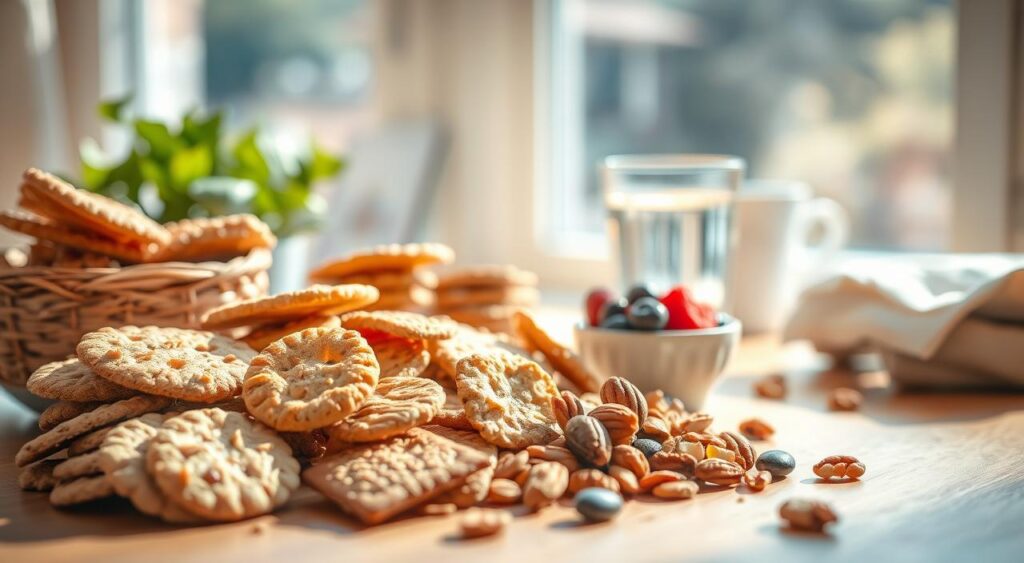
Healthy Snack Options
Opt for snacks with a mix of carbs, protein, and healthy fats. Greek yogurt with berries is a great choice. It offers calcium, protein, and carbs in a small package.
Raw veggies with hummus, a handful of almonds or walnuts, and low-fat string cheese with an apple are good options. Cottage cheese with cucumber or whole-grain crackers with peanut butter also work well if you watch your portions.
How to Snack Wisely
Go for snacks with 15–30 grams of carbs, based on your meal plan and glucose goals. Count carbs carefully if you’re on insulin to keep your doses right.
Pairing carbs with protein or fat helps slow down digestion. For instance, apple slices with peanut butter or berries with ricotta keep blood sugar levels stable better than carbs alone.
| Snack | Typical Carb (g) | Protein/Fat | Why it works |
|---|---|---|---|
| Plain Greek yogurt (3/4 cup) + 1/4 cup berries | 15–20 | 10–12 g protein | Balanced carbs for type 2 diabetes; protein slows absorption |
| 1 small apple + 1 tbsp peanut butter | 20–25 | 8 g fat/protein | Healthy carbohydrates for diabetes combined with fat for steady glucose |
| 10 baby carrots + 2 tbsp hummus | 10–15 | 3–4 g protein | Low-carb veg choice that supports managing carbs with diabetes |
| 1 oz almonds (about 23 nuts) | 5–6 | 14 g fat/protein | Low-carb, high-satiety snack to prevent overeating at meals |
| Low-fat string cheese + 1 small pear | 15–20 | 7–8 g protein | Portion-controlled combo that balances carbs and protein |
Keep your snack portions small and track carb counts. Adjust your snacks to meet your glucose goals. If you prefer fewer snacks, plan meals that are balanced to reduce hunger and meet your nutritional needs.
The Importance of Portion Control
Controlling portions is key to keeping carbs steady for type 2 diabetes. Even small mistakes in serving size can cause blood sugar spikes. Learning to judge portions helps avoid these spikes and improves health.
Managing Portion Sizes
Start by reading Nutrition Facts to see carbs per serving. A small baked potato has about 30 g of carbs, which is two carb servings for many plans.
Use visual cues when you can. A clenched fist is roughly one cup of vegetables or starch. Your palm is about 3–4 ounces of protein. Your thumb is about one tablespoon of fat or nut butter.
When eating out, ask for nutrition info or choose non-starchy veggies as sides. Splitting an entree with a friend or ordering a half portion reduces carbs without losing flavor.
Tools for Measuring Portions
Practical tools help you measure carbs accurately for type 2 diabetes. A digital food scale gives precise weights. Measuring cups and spoons work well for cooked grains, cereals, and sauces.
Preportioned containers and smaller plates help control portions without constant measuring. For insulin dosing, weigh or measure foods until you know typical portions by sight.
Keep a simple habit of scaling grams of carbohydrate from the label to match your actual portion. This practice makes managing carbs with diabetes more consistent and less stressful over time.
Special Considerations for Managing Carbs
Small changes in carbs can make a big difference. Your activity level, age, weight, medications, and goals all play a role. Use these tips to manage carbs for type 2 diabetes effectively.
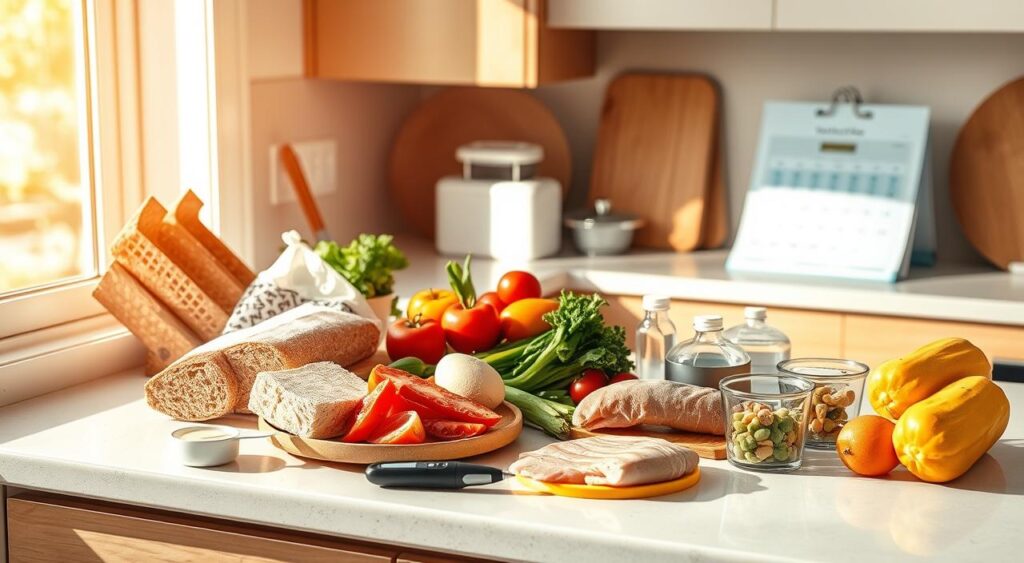
Carb Needs for Different Activity Levels
If you’re active, your body uses more glucose. This means you might need more carbs before, during, or after exercise to avoid low blood sugar.
For light activity, stick to whole grains, fruits, and veggies. For more intense workouts, add a small carb snack like a banana or whole-grain toast 30–60 minutes beforehand.
During long workouts or hikes, refuel every 45–90 minutes. Watch how your body reacts to adjust carbs safely with your medication.
Age and Weight Considerations
As you get older, your appetite and chewing might change. Older adults might need fewer calories but keep carbs rich in nutrients for energy and digestion.
Trying to lose weight? Cutting carbs can help you lose calories and improve insulin sensitivity. Even a little weight loss can lower insulin resistance and change how many carbs you can handle.
Your weight and metabolic health are key. If you’re heavier or have more insulin resistance, you might need fewer carbs at meals. Losing weight means you can reassess your carb targets and talk to your doctor before changing your medication.
| Factor | Practical Tip | Example |
|---|---|---|
| Low Activity | Lower meal carbs, focus on fiber and protein | 1 small apple + 2 tbsp peanut butter after lunch |
| Moderate Exercise | Include 15–30 g carbs pre-activity or a carb-protein snack | Greek yogurt with berries 45 minutes before a 45-min walk |
| Intense/Long Exercise | Plan carb refueling during activity to prevent hypoglycemia | Half a sports gel or 20 g raisins every hour for long runs |
| Older Adults | Smaller, nutrient-dense portions; soft textures if needed | Mashed sweet potato with cottage cheese at dinner |
| High Body Weight/Insulin Resistance | Reduce refined carbs; aim for steady, lower-carb meals | Salad with grilled salmon, quinoa limited to 1/3 cup |
| On Insulin or Sulfonylureas | Coordinate carb timing and dose with your clinician | Adjust rapid insulin when adding a pre-workout snack |
Keep a log of your activity, meals, and glucose levels. This helps you see patterns and refine your carb plan. Always talk to a registered dietitian or your diabetes care team before making big changes to your carb intake or medications.
Working with a Dietitian
Working with a registered dietitian or a certified diabetes care and education specialist offers personalized help. They consider your medications, activity level, and food preferences. This way, they create a plan that suits your lifestyle.
How a Dietitian Can Help
A dietitian teaches you how to count carbs for type 2 diabetes. They show you how to match food with your medication and activity. You’ll learn about the plate method, portion guides, and sample menus.
They also teach you how to read labels and shop for whole grains, fiber-rich foods, and nutrient-dense carbs. This helps you make better food choices.
They work with your healthcare team to adjust your medication when needed. This teamwork helps avoid blood sugar swings. You’ll learn how to manage carbs with diabetes in everyday life.
Setting Goals with Professional Guidance
With a dietitian, you set realistic goals like losing a little weight or improving your A1C levels. They help you break down big goals into smaller steps. This makes it easier to track your progress.
Small changes in carb portions and timing can lead to big results. Ask your healthcare provider for a referral to DSMES programs. Or use a Find a Diabetes Education Program locator to find services near you.
Regular follow-ups help you refine your goals and adapt your meal plans. This keeps you confident in managing your carbs with diabetes.
The Role of Technology in Carb Management
Technology offers tools to track food, check portions, and link glucose readings to meals. You can use apps and devices to make carb counting easier. This helps you see how meals affect your glucose levels. Choose tools that fit your lifestyle and privacy needs.
Many smartphone apps and online food databases make carb counting easier for type 2 diabetes. Apps like MyFitnessPal and Carb Manager help you find Nutrition Facts, convert portions, and log meals. This way, you can track total carbohydrate grams.
Apps like Glucose Buddy and those from Dexcom and Abbott FreeStyle Libre sync glucose trends with meal times. This helps you learn which carbs raise your readings and which keep you steady. Look for features that show patterns over days and weeks.
Continuous glucose monitors from Dexcom and Abbott give near-real-time glucose data. You can test how different carbs and portions change your levels within minutes. Use this feedback to refine carb counting and spot unexpected responses to fiber or sugar alcohols.
Some insulin pumps and dose calculators include carb counting tools. These help adjust insulin for meals. Always cross-check calculated doses with Nutrition Facts and your healthcare team’s guidance. Rely on total carbs, not net-carb claims, when making dosing decisions.
Wearable devices and smartwatches can record activity and link it to glucose and food logs. Combining movement with food entries helps you understand how exercise modifies your carb needs. Use these insights for managing carbs with diabetes when planning meals around activity.
Watch for how fiber and sugar alcohols affect your glucose. Net-carb claims may not reflect your personal response. Track your own glucose after meals to see which carbs for type 2 diabetes change your numbers most.
Choose apps and devices that protect your data and offer easy export to share with dietitians or endocrinologists. When used thoughtfully, technology can simplify carb counting for type 2 diabetes. It supports smarter choices for managing carbs with diabetes.
Common Mistakes in Carb Management
Managing carbs for type 2 diabetes takes time to master. Small mistakes can raise your blood sugar more than you think. Here are common errors and how to fix them to better control your blood sugar.
Misunderstanding Carb Types
It’s easy to focus only on sugars and miss the rest. The Nutrition Facts label shows Total Carbohydrate. This includes starches, sugars, and fiber.
Don’t rely on “net carbs” or think “sugar-free” means low-carb. Processed snacks, diet sodas, and many low-sugar bars have carbs too. Use carb counting for type 2 diabetes to track all carbs, not just sugar.
Neglecting Portion Control
Restaurant portions are often too big. A single plate of rice or a big bakery roll can have many servings. If you don’t measure, you might eat too many carbs and see your blood sugar spike.
Measure starchy foods like potatoes, rice, and pasta until you can guess by eye. Track snacks between meals because they add up quickly. Good portion control helps you avoid surprises when checking your blood glucose.
Other Common Errors and Fixes
Some people ignore fiber’s benefits or trust labels too much. Others change carbs but forget to adjust meds or exercise timing. Skipping education from a certified diabetes care team leaves gaps in care.
- Read labels and use Total Carbohydrate as your guide.
- Measure portions and log snacks to prevent hidden carbs.
- Monitor your blood sugar after meals to learn what affects you.
- Discuss changes with your dietitian or endocrinologist before altering meds.
Knowing which foods to avoid with diabetes helps pick meals that keep glucose steady. Use carb counting for type 2 diabetes with portion control and regular glucose checks. For personalized advice, see a DSMES or a registered dietitian.
Your Journey with Carbs and Diabetes
Managing carbs is a personal journey that fits into your daily life. Start with small, measurable goals. For example, aim for a certain number of carb grams per meal. Or, try to cut down on added sugars and lower your A1C by a specific amount.
Focus on healthy carbs like non-starchy vegetables, whole grains, legumes, and fruit. These help build sustainable habits.
Setting Personal Goals
Make your goals realistic and specific. This way, you can track your progress. For instance, aim for consistent carb counts at meals or increase your fiber intake.
Replace sugary drinks with water. Work with a registered dietitian or your clinical team. This ensures your goals align with your medications and lifestyle.
Tracking Progress and Being Flexible
Use a log or app to track your food and blood glucose. Regular A1C checks are also important. Consider DSMES programs and tools like continuous glucose monitors when needed.
Be prepared to adjust your intake for different situations. If trying a low-carb plan, do so under medical supervision. Use trusted resources and technology to manage carbs for type 2 diabetes.

